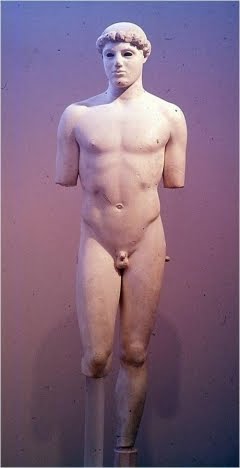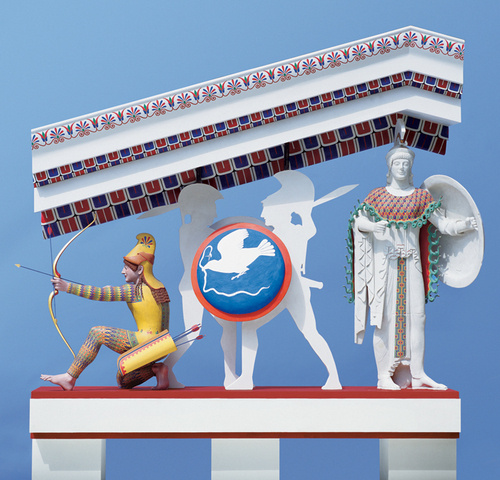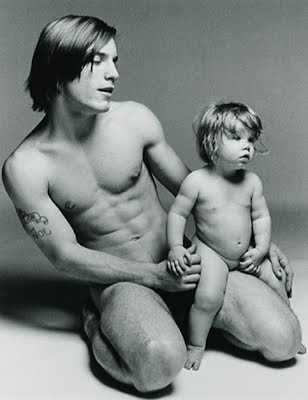Each put forth his views forcefully in 1956, a period of transition from prudery to, well, licentiousness.
Recently, friend Rik Isensee sent me a quotation by Leonardo dv Vinci, written some five centuries ago, tht stated me thinking anew about the way penaii (my own spelling of the plural of "penis") and the human body are viewed.
Clark's view, with its elegant style and clear prose, was intended, I think, to mark the beginning of a new way of seeing unclothed bodies. Instead, it marked the end of a long era. Ginsberg's view caught or unleashed something in the Western psyche that is still unfolding and I don't see the end of the changes, but the changes are radically different from the norm in 1956.
Those you who are not interested in penaii might still be interested in the history of the West's varying views on that small, potent pat of the male body.
The eye blinks, and thousands of years of our (Western) ancestral history posses. Our Greek ancestors thought of their penaii as we might think of our elbows . . .
This is the God Zeus seducing the child Ganymede, 6th Century, BCE.
This theme remains a favorite of artists [Rembrandt entitles this "The Rape of Ganymede"]
A contemporary version by Vittorio Carvelli
and beer advertisers
to the present day, though sex with children is about the only thing Google-Charon, our guide to the digital Underworld, won't permit, now-a-days.
We modern folks have recently been able to determine the original color of Greek statues. Artists are painting reproductions as the Greeks saw them. I like it; some don't.
The recreation of portion of a pediment, colorized
Laocoön (160 or 120 BCE)
Ganymede, again
Showing the development of style
I have two quarrels with our Greek ancestors: there were more slaves than freemen; and women were little better off than slaves. The fate of women, in the West, is finally good. Communists, for a century, have insisted on sexual equality, though I don't know how that works out in practice. [Scan the Web: half the articles seem to say that women's rights in China are good; and half disagree. Don't know who is right, nor who to trust on the subject.] The rest of the world is no better than the West 500 years BCE.
Still, I like penaii and the freedom to expose it with ease.
This interesting pic shows the development of style over time.
The Greco-Roman years pass quickly, for us, to be replaced by he Judeo-Christian years of shame, fear, and torture.
Christianity darkened the West, as its brother religion, Islam, is now doing in the Middle East and Central Asia. Figure life in Europe in 1400 was pretty much like life in Afghanistan today, except for advances in mass murder.
The Dark Ages did produce works of beauty -- for example, in architecture,
detail
but the human body was shameful, disgusting, and not displayed, . . .
. . . except in images of torture and death. . .
and penaii were never displayed, with one exception: Christ's penis could be displayed, because (it is said) he was born without the use of a penis, and he didn't use his, either (it is said) except, presumably, to pee. Church tradition doesn't mention wet dreams.
There is no scriptural authority for a belief that Jesus used his penis only to pee, but that is a firmly held belief by Christians of all sorts. In the Dark Ages, Jesus' penis was thought of as so holy that a scrap of his foreskin was a most scared relic, preserved, it is said, in a thousand churches.
For these and many other interesting bits of information about the history of penaii, read The Sexuality of Christ in Renaissance Art and in Modern Oblivion by LEO STEINBERG.
Since Christ's penis was so holy, it was thought in the 14th and 15th Centuries, that his penis was good to show
15th Century
1948 Christian Church Art
14th Century
Made of chocolate; quite an uproar
Darkness passed, Enlightenment bloomed (thanks to Arabian scholars who had kept Greek learning alive for centuries), and penaii again become accepted as a part of the human body.
Michelangelo's hugh statue of David (1501-03) has the West's most famous penis,
though I like the sexier Perseus (Cellini 1944-54) standing in Florence, just across the loggia from David, better.
same theme by Peter Paul Reubens though with a token covering:
Or, if you are distracted by the little wisp of cloth, Rubens' Hero and Leander
Leonardo da Vinci summed up the Renaissance mood like this:
"[The phallus] confers with the human intelligence and sometimes has intelligence of itself, and although the will of the man desires to stimulate it it remains obstinate and takes his own course, and moving sometimes of itself without license or thought by the man, whether he be sleeping or waking, it does what it desires; and often the man is asleep and it is awake, and many times the man is awake and it is asleep; many times the man wishes it to practice and it does not wish it; many times it wishes and the man forbids it. It seems therefore that this creature often has a life and intelligence separate from the man, and it would appear that the man is in the wrong in being ashamed to give it a name or exhibit it, seeking rather constantly to cover and conceal what he ought to adorn and display with ceremony as a ministrant."
Quoted in Leonardo da Vinci by Sherwin B. Nuland
Quite right. "It seems therefore that this creature often has a life and intelligence separate from the man. . . ." Perhaps that's why the Children of Abraham - Muslims, Jews, and Christians - hate and fear penaii so much: Abraham, by his cruel treatment of his children Isaac and Ishmael, taught them to hate and fear what they could not control. The boys grew up to father many men, who fathered many men, who are now the Arabs, the Jews, and, by adoption into an off-spring of Jewish faith, the Christians.
And Leonardo's view prevailed for a while " . . . man is in the wrong in being ashamed to give it a name or exhibit it, seeking rather constantly to cover and conceal what he ought to adorn and display with ceremony as a ministrant."
And so, the codpiece:
But soon enough the Vaticides (if we may take he spirit of Leonardo s a prophet) and Victorians reimposed fear and shame, and we got, in exchange, exceptionally beautiful seascapes (this one tinged with humanity, for it is said to show the bodies of dead and dying slaves being thrown overboard a foundering slaver), this painting by Turner
and the jailing of the brilliant Oscar Wilde
for proclaiming his love for Boopsie - er, Lord Alfred Douglas
And so we rocked along, mostly ignoring penaii, though Picasso did a cute one (Boy Leading a House, 1905-6),
through the American and French and Russian Revolutions, Darwin's Origin of Species (from which we could have learned much more than we did), the First World War (the war to make the world safe for democracy), the Second Wold War (the "good" war), and, then, back to penaii, which had been absent for nigh on to four centuries.
Two things happened in 1956 that made a difference.
The first was the publication of The Nude: A Study in Ideal Form, by Sir Kenneth Clark. The setting: Andre Malraux and others had noted that the publication of works of art in books was like the creation of museums without walls: the great works had become available to any who wanted to look.
To give you youngsters context, the scene pictured below from From Here to Eternity (1953), created an enormous stir because is was widely thought to be indecent:
Clark's book
opened this Texan's eyes. I had never before seen images of penaii; here was a whole book full of them, and approved as worthy of peering at. In Clark's words,
The English language, with its elaborate generosity, distinguishes between the naked and the nude. To be naked is to be deprived of our clothes, and the word implies some of the embarrassment most of us feel in that condition. The word "nude," on the other hand, carries, in educated usage, no uncomfortable overtone. The vague image it projects into the mind is not of a huddled and defenseless body, but of a balanced, prosperous, and confident body: the body re-formed.
The body re-formed. Safe to peer at. Safe to proclaim one is peering at it. A bombshell.
Clark has a point. Many of us do react when suddenly exposed:
What I call "the shit-eating grin"; nearly a feral snarl, but not quite, because it's all supposed to be in good fun. However, "nude", to educated Clark, carries no uncomfortable undertones, ignoring the blatant sexuality of many of the fine paintings gentlemen are presumed to admire for qualities other than sex (and indeed, Clark, to his credit, explores, with wit and erudition, many of those qualities, not to be denigrated, in the book). Here's Clark's way of looking at the world:
I believe order is better than chaos, creation better than destruction. I prefer gentleness to violence, forgiveness to vendetta. On the whole I think that knowledge is preferable to ignorance, and I am sure that human sympathy is more valuable than ideology. I believe that in spite of the recent triumphs of science, men haven't changed much in the last two thousand years; and in consequence we must try to learn from history.
I agree completely.
As Clark was writing what an educated man would see in an image which included penaii, someone who was definitely not a gentleman was busy inventing a new way of seeing the world.
Alan Ginsberg, in a footnote to Howl:
Holy! Holy! Holy! Holy! Holy! Holy! Holy! Holy! Holy!
Holy! Holy! Holy! Holy! Holy! Holy!
The world is holy! The soul is holy! The skin is holy!
The nose is holy! The tongue and cock and hand
and asshole holy!
Everything is holy! everybody's holy! everywhere is
holy! everyday is in eternity! Everyman's an
angel!
The bum's as holy as the seraphim! the madman is
holy as you my soul are holy!
The typewriter is holy the poem is holy the voice is
holy the hearers are holy the ecstasy is holy!
Holy Peter holy Allen holy Solomon holy Lucien holy
Kerouac holy Huncke holy Burroughs holy Cas-
sady holy the unknown buggered and suffering
beggars holy the hideous human angels!
Holy my mother in the insane asylum! Holy the cocks
of the grandfathers of Kansas!
Holy the groaning saxophone! Holy the bop
apocalypse! Holy the jazzbands marijuana
hipsters peace & junk & drums!
Holy the solitudes of skyscrapers and pavements! Holy
the cafeterias filled with the millions! Holy the
mysterious rivers of tears under the streets!
Holy the lone juggernaut! Holy the vast lamb of the
middle class! Holy the crazy shepherds of rebell-
ion! Who digs Los Angeles IS Los Angeles!
Holy New York Holy San Francisco Holy Peoria &
Seattle Holy Paris Holy Tangiers Holy Moscow
Holy Istanbul!
Holy time in eternity holy eternity in time holy the
clocks in space holy the fourth dimension holy
the fifth International holy the Angel in Moloch!
Holy the sea holy the desert holy the railroad holy the
locomotive holy the visions holy the hallucina-
tions holy the miracles holy the eyeball holy the
abyss!
Holy forgiveness! mercy! charity! faith! Holy! Ours!
bodies! suffering! magnanimity!
Holy the supernatural extra brilliant intelligent
kindness of the soul!
Sublime chaos. I also completely agree with Ginsberg. I suppose I'll take that dichotomy (Clark and Ginsberg) with me to the end.
Perhaps Ginsberg seems commonplace now; his point of view was unprecedented in the 50s:
The nose is holy! The tongue and cock and hand
and asshole holy!
Everything is holy! everybody's holy!
So Andy Warhol and Joe Dallesandro are holy.
Almost simultaneously, Joe Dallesandro was filming Flesh, Trash, and Heat and the cock came out of the closet, and perhaps, because of the internet, never to be put back in again.
If you haven't seen Andy Warhol's Dracula you've missed one of the great films of all times. The movie explores the geometry of need with more accuracy, humor, and grace than anything I know. And it stars Dallesandro.
Of course, if you grew up on Marky Mark, Joe may be old hat. . .
and now even Marky Mark is old hat . . . .
[Isn't this somebody's child? Shouldn't he be home studying or in bed?]
I'll decline, out of deference to my own withered sense of propriety, to show you the horrific images of explicit sexual sadism, male and female, available to any 5-year-old who wishes to surf the Web. Horrific, but not more than horrific 17th Century paintings commissioned by the Church to hang on alters, to attract parishioners wavering because of the Reformation. For example, The Martyrdom of St. Erasmus
[Note the windlass onto which the saint's intestines are being wound: the windlass is why St. Erasmus is a patron of sailors. Painting by Nicholas Poussin, one of the greatest and most restrained of Baroque painters.]
The Web has hundreds of offers to paint a version of St. Erasmus' evisceration, suitable for hanging in your own living room. You may chose the 14th Century version
or the Poussin version
Who are these people?
You are welcomed to explore Web images for yourself. If you haven't already, you should see what 5-year-olds are looking at. Web content contains some predicator of consequences for the future of the world (images are available world-wide: my own blogs are seen in non-Muslim countries such as Poland and India and Uruguay, for example), but I cannot tell if for good or ill. I guess our kids won't grow up worse than Baroque kids did -- not saying much, I know.
I suppose the trend toward image openness will not soon come to an end but rather will become commonplace and uninteresting. It may already be so, to some of you. Would that I were prescient.
In the mean while, what in the name of Pete is JAPAN UP TO?






















































No comments:
Post a Comment